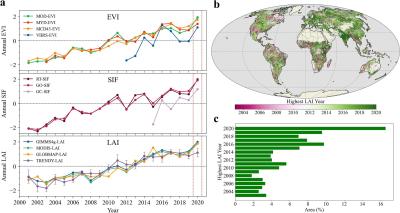Earth’s Record-High Greenness and Its Attributions in 2020
Record-high global greenness in 2020 was detected, attributed, and analyzed using multi-source remote sensing, machine learning, and land surface model simulations.
By uncovering detailed drivers of the record-high greenness in 2020, this study advanced understanding of vegetation resilience to climate change, offered insights for climate mitigation and ecosystem management, and provided findings and methods valuable to scientists and policymakers alike.
Record-high global greenness was observed in 2020, with significant contributions from CO₂ fertilization, climate warming, and reforestation efforts, especially in boreal and temperate regions. Short-term rainfall increases boosted tropical greenness, while COVID-19 lockdowns had minimal impact on this greening anomaly. Using multi-source remote sensing, machine learning, and Earth system models, the study distinguished between long-term trends and short-term variability in vegetation growth. Future projections suggest that sustained CO₂-driven greening might continue, but regional impacts will vary. These findings highlight the resilience of global vegetation and underscore the importance of tailored climate mitigation and ecosystem management strategies.

